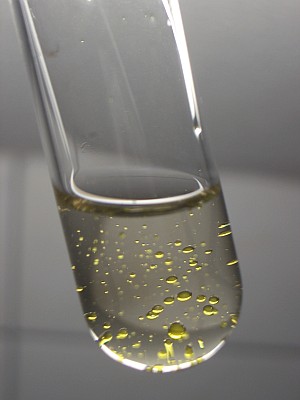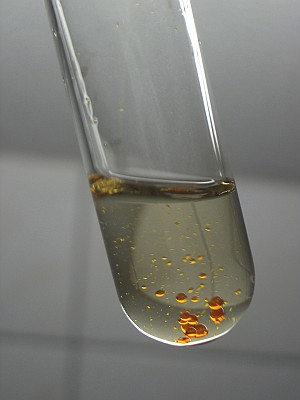Originally posted by woelen
...
Conclusion: Vanadium does not catalyse the reaction. Vanadium in the +5 oxidation state is reduced by the S to vanadium in the +4 oxidation state
(bright blue color is due to vanadyl, VO(2+)). The further step, the formation of the ochre/yellow precipitate, is not clear at all to me. Is this
some sulfide of vanadium? I could not find info on such a compound. So, we have a new, interesting riddle, but absolutely no catalyst.
The sulphur is indeed the reductor, because without sulphur, vanadium is not reduced, the boiling hot solution remains deep red.
|





 I'd be much
more comfortable injecting liquid S at a metered rate into the hot H2SO4 if that is the case, although at that temp water dilution would not be a
problem
I'd be much
more comfortable injecting liquid S at a metered rate into the hot H2SO4 if that is the case, although at that temp water dilution would not be a
problem



 What is not green
is dumping.
What is not green
is dumping.
 . Good stirring would surely be a great idea
with this two-phase reaction. I bet that's why using pumice is suggested, for increasing the surface area between reactants. Maybe diatomaceous earth?
. Good stirring would surely be a great idea
with this two-phase reaction. I bet that's why using pumice is suggested, for increasing the surface area between reactants. Maybe diatomaceous earth?
 . I hope to find some time for repeating the experiment this evening. Right now, I do
think that I did not heat sufficiently strong, and that indeed the fuming I observed was at a lower temperature. For me, this issue must be settled,
once and for all
. I hope to find some time for repeating the experiment this evening. Right now, I do
think that I did not heat sufficiently strong, and that indeed the fuming I observed was at a lower temperature. For me, this issue must be settled,
once and for all  . I'll use a Duran/Jena-glass tube and heat until the acid starts
boiling and see what happens. I'll also try adding a pinch of metal salts.
. I'll use a Duran/Jena-glass tube and heat until the acid starts
boiling and see what happens. I'll also try adding a pinch of metal salts. ). I might try the iron tomorrow, if I find some time for it. The Hg I don't
try, I don't want to poison myself with volatile mercury compounds or mercury metal vapor.
). I might try the iron tomorrow, if I find some time for it. The Hg I don't
try, I don't want to poison myself with volatile mercury compounds or mercury metal vapor.
